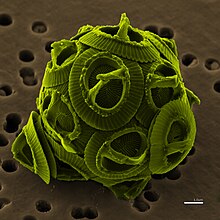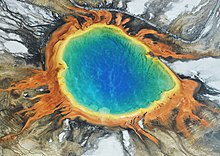Geomicrobiology

Geomicrobiology is the scientific field at the intersection of
Rocks and minerals
Microbe-aquifer interactions
Microorganisms are known to impact aquifers by modifying their rates of dissolution. In the karstic Edwards Aquifer, microbes colonizing the aquifer surfaces enhance the dissolution rates of the host rock.[8]
In the oceanic crustal aquifer, the largest aquifer on Earth,[9] microbial communities can impact ocean productivity, sea water chemistry as well as geochemical cycling throughout the geosphere. The mineral make-up of the rocks affects the composition and abundance of these subseafloor microbial communities present.[10] Through bioremediation some microbes can aid in decontaminating freshwater resources in aquifers contaminated by waste products.
Microbially precipitated minerals
Some bacteria use metal ions as their energy source. They convert (or chemically reduce) the dissolved metal ions from one electrical state to another. This reduction releases energy for the bacteria's use, and, as a side product, serves to concentrate the metals into what ultimately become ore deposits. Biohydrometallurgy or in situ mining is where low-grade ores may be attacked by well-studied microbial processes under controlled conditions to extract metals. Certain iron, copper, uranium and even gold ores are thought to have formed as the result of microbe action.[11]
Subsurface environments, like aquifers, are attractive locations when selecting repositories for
Environmental remediation
Microbes are being studied and used to degrade organic and even
Soil and sediment: microbial remediation

Microbial remediation is used in soils to remove contaminants and pollutants. Microbes play a key role in many
Many heavy metals, such as
Acid mine drainage
Another application of geomicrobiology is
Bioremediation techniques are also used on contaminated
Microbial degradation of hydrocarbons
Microbes can affect the quality of oil and gas deposits through their metabolic processes.[19] Microbes can influence the development of hydrocarbons by being present at the time of deposition of the source sediments or by dispersing through the rock column to colonize reservoir or source lithologies after the generation of hydrocarbons.
Early Earth history and astrobiology

A common field of study within geomicrobiology is origin of life on earth or other planets. Various rock-water interactions, such as serpentinization and water radiolysis,[12] are possible sources of metabolic energy to support chemolithoautotrophic microbial communities on Early Earth and on other planetary bodies such as Mars, Europa and Enceladus.[20][21]
Interactions between microbes and sediment record some of the earliest evidence of life on earth. Information on the life during
Extremophiles

Another area of investigation in geomicrobiology is the study of
Observations and research in hyper-saline
In July 2019, a scientific study of
See also
- Bacterial oxidation
- Desulforudis audaxviator
- Deep biosphere
References
- PMID 22615387.
- ^ PMID 20019082.
- ^ U.S. Geological Survey (2007). "Facing tomorrow's challenges - U.S. Geological Survey science in the decade 2007-2017". U.S. Geological Survey Circular. 1309: 58.
- ^ ISBN 978-1444309027.
- ^ S2CID 95354248.
- ^ "Mitigation of Climate Change in Agriculture (MICCA) Programme | Food and Agriculture Organization of the United Nations". www.fao.org. Retrieved 2019-10-02.
- )
- PMID 23151637.
- .
- S2CID 131278563.
- PMID 15877814.
- ^ .
- S2CID 3312488.
- .
- .
- )
- .
- .
- PMID 2215423.
- PMID 27267306.
- PMID 16689653.
- .
- PMID 22949693.
- PMID 28486437.
- PMID 24205812.
- ^ Thomas D. Brock. "Colorful Yellowstone". Life at High Temperatures. Archived from the original on 2005-11-25.
- .
- ISBN 978-94-007-0396-4.
- S2CID 199636268.
- ^ World's Oldest Groundwater Supports Life Through Water-Rock Chemistry, July 29, 2019, deepcarbon.net.
- ^ Strange life-forms found deep in a mine point to vast 'underground Galapagos', By Corey S. Powell, Sept. 7, 2019, nbcnews.com.
Further reading
- Ehrlich, Henry Lutz; Newman, Dianne K., eds. (2008). Geomicrobiology (5th ed.). Hoboken: Taylor & Francis Ltd. ISBN 978-0849379079.
- Jain, Sudhir K.; Khan, Abdul Arif; Rai, Mahendra K. (2010). Geomicrobiology. Enfield, NH: Science Publishers. ISBN 978-1439845103.
- Kirchman, David L. (2012). Processes in microbial ecology. Oxford: Oxford University Press. ISBN 978-0199586936.
- Loy, Alexander; Mandl, Martin; Barton, Larry L., eds. (2010). Geomicrobiology molecular and environmental perspective. Dordrecht: Springer. ISBN 978-9048192045.
- Nagina, Parmar; Ajay, Singh, eds. (2014). Geomicrobiology and Biogeochemistry. Berlin, Heidelberg: Springer Berlin Heidelberg. ISBN 978-3642418372.

